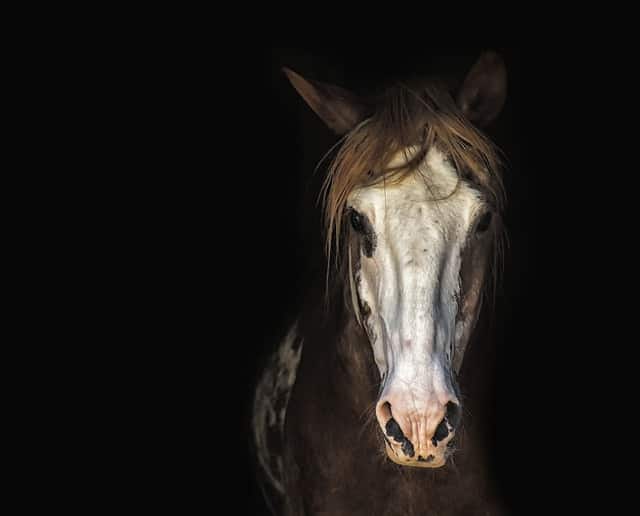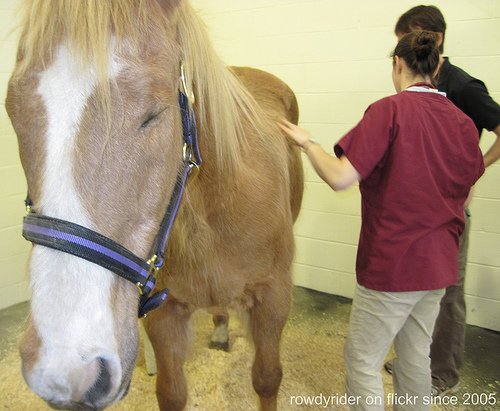
Most people are familiar with the concept of spaying dogs and cats. But have you ever heard of anyone who spayed their mare? I haven’t. As a mare owner myself for almost five years now, the possibility hasn’t even once come up in conversation with my vet. As the owner of a female dog, that question lurked from day one. When is she old enough to spay? What happens if she accidentally gets pregnant before she’s old enough to spay? But, as a mare owner, that wasn’t even a question. We’ve had four mares now and all were — to our knowledge — intact. It was never a question or a concern. So why are horses so different from dogs or cats?
Spaying a Mare vs Gelding a Stallion
First let’s look at the practical differences between spaying and gelding. A stallion’s reproductive organs are primarily on the outside. Therefore, the procedure required to remove said reproductive organs and turn the stallion into a gelding is not very invasive. It just involves removing the testicles which generally takes about thirty minutes and another two weeks of stall rest to recover. Quick and easy, no muss, no fuss as long as there are no unforeseen complications.
To spay a mare, on the other hand, is a whole different can of worms. The most common type of spay for a mare is an ovariectomy which only removes the ovaries as opposed to a full spay which takes the ovaries and the uterus.
There are three different approaches veterinarians can take to spay a mare. They can go in through the abdominal cavity — similar to the way dogs and cats are commonly spayed — make and incision below the flank, or go in through the vagina. The vaginal method is much quicker and generally costs 1/4 of what the other types of surgery will cost. However, it is not as common because it requires a higher level of expertise. The flank or abdominal methods can cost anywhere from $1,000-3,000. The vaginal method can cost as low as $250.
So why don’t we spay?
With the huge push to spay dogs and cats, one does wonder why there isn’t the same push to spay horses. A big argument for spaying dogs and cats is overpopulation and backyard breeders. This same issue is often addressed with horses. However, spaying is only ever brought up in relation to wild horses, never in conversations about domesticated stock.
The big difference is in the statistical chances of unplanned pregnancy. I currently have three mares in the barn and one mini gelding. Never have I once been concerned about unplanned pregnancy. I live in an area where horses are fairly common. Of my horse-owning neighbors, none — to my knowledge — own stallions. I do know of two stallions that live nearby. But they are a few miles away. One is properly contained. One is not, however he has never been a problem and most of our perimeter fences are 6-foot high and electrified, so good luck getting in before we find out.
The point is, we are much more conscientious about the containment of our half-ton beasties than we are of 20-lb Fido. An stallion is often dangerous and unpredictable in the wrong hands which is why no one really questions gelding them. There are far less stallions running around than intact male dogs. There are probably no less than a dozen intact dogs in my rural neighborhood, most of which aren’t contained. But there are only two stallions, both of which are contained. The risk of unwanted dog pregnancies is very high. The risk of unwanted equine pregnancies is very low unless you are really unlucky.
When is it necessary to spay?
Spaying a mare is really only necessary if it is for health or behavioral reasons. Some mare have a lot of pain when they go into heat which — along with hormonal imbalances — causes dangerous behavior problems. In some cases, you vet may recommend spaying if you have no plans on breeding. Another big problem that can necessitate spaying is ovarian tumors. In some cases, it is necessary to remove the ovaries with the tumors.
Over all, it is not really necessary to spay your mare unless there is a real health or behavioral reason. There is always a certain amount of danger that goes with anesthesia that should be avoided if the procedure is not medically necessary.










In most cultures it is considered an insult to ride anything less than a stallion. When I go abroad they always give me a stallion to ride. Especially the Spanish and Portuguese speaking places. It is a sign of respect to give me a stallion to ride.
Robert your comment is so untrue. There are plenty of reasons to not have stallions around. For those that have many horses they may not be setup to keep a stud around. Yes, their manners may be good when riding if they are handled and trained from day 1. However, they still have testosterone and if there are mares on your place then there are potential problems.
In response to the original article mares have been being spayed for decades. People often do it to prevent the “mare” attitude in their good working horses if they have no intent of breeding them. In the working ranch situation there are places that wont allow mares on their places. Spaying is an alternative to getting rid of a good horse.
This article is biased, if not racist. There are many cultures in the world that do not have geldings. Gelding is specific to certain northern Europeans and that’s all. The real reason White people having geldings is because they are lousy stallion trainers. There no reason for poorly behaved stallions other than bad training.